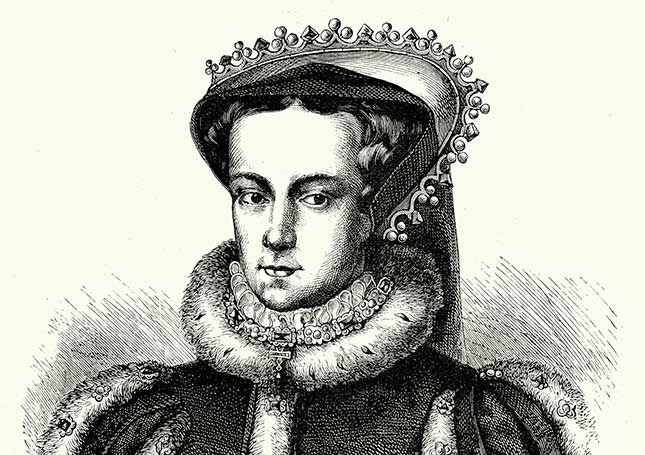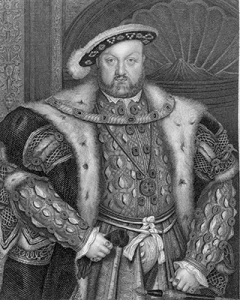
With Tudor Times we profile a different figure every month. Here, Melita Thomas explores Mary Tudor, England’s first sovereign queen.
Mary Tudor, as she is commonly known, was the first woman crowned as sovereign in England. For centuries her name has been remembered with loathing, by the horrible epithet ‘Bloody Mary’, but there is far more to Mary’s astonishing story than later propaganda suggests.
Mary was the daughter of Henry VIII and his first wife, Katharine of Aragon, and during her childhood was doted on by both parents. A pretty and intelligent child, she was used as a bargaining tool in promoting foreign alliances. She was betrothed to the Dauphin of France, the Emperor, the Duke of Orleans and the King of France at different times, before she was 12 years old.
By the time Mary was nine, it became apparent that Katharine would not bear more children, so Henry was faced with the prospect of either naming as his heir, either Mary, or her illegitimate half-brother, Henry Fitzroy. The king, unwilling to commit himself to either course, hedged his bets, promoting Fitzroy to royal dukedoms, but granting Mary a large household and sending her to preside over the Council for Wales in the tradition of previous Princes of Wales. Although not granted the title of Princess of Wales, Mary was often referred to by it.

Then came the trauma that would change not just Mary’s life, but the course of English history. Her father decided the best solution to the problem of the succession was to remarry – and he had a candidate for a second wife in mind, the bewitching Anne Boleyn. Katharine, supported by Mary, bitterly opposed the proposed annulment and Henry battled for seven years to persuade the Pope to grant it, but Mary’s maternal cousin, the Emperor Charles V, would not allow the Pope to rule in Henry’s favour.
Eventually, Henry threw off papal authority and married Anne without it. Mary was separated from her mother, stripped of her rank, her jewels and her dignity, and obliged to share a household with Anne’s new daughter, Elizabeth. Finally, aged 20, bullied and browbeaten, Mary was forced to sign the oath accepting the annulment of her parents’ marriage, and Henry’s new position as Supreme Head of the Church, although it is apparent that, in her heart, she rejected both propositions.
As soon as she proved herself obedient, Mary was restored to favour, and for the rest of Henry’s life, lived in and around Henry’s court, on good terms with her later step-mothers and particularly close to Henry’s last wife, Katherine Parr, with whom she shared intellectual interests.
In the Act of Succession 1544, Mary was confirmed as second in line to the throne, after her half-brother Edward, but on Edward’s death there was an attempt to replace her with her Protestant cousin, Lady Jane Grey. Mary would not tolerate such a usurpation of her rights. She demanded that the Council proclaim her as queen, then began to gather troops, preparing to fight for the throne, emulating her grandmother, the warrior queen, Isabella of Castile. But force was unnecessary – support for Mary was overwhelming and she was swiftly proclaimed queen, entering London in triumph in August 1553.
Mary was crowned on 1 October 1553, and it was clarified by Parliament that she had all the powers and authority of kings, which she used, to both good effect and ill.
Policies were introduced to control the chronic inflation, partially caused by the debasement of the coinage in the previous reigns. Two new ships were built for the navy, money was spent on the universities and the treason laws introduced by Henry VIII that made not just actions, but words, treasonable, were repealed.
Brought to the throne on a tidal wave of popular support, Mary sought to undo the religious changes of the previous 20 years, while introducing important reforms in Catholic education and the quality and training of priests. But, whilst the overwhelming majority of her subjects were Catholic, a solid and vociferous minority had embraced Protestantism whole-heartedly, and were willing to die rather than renounce their faith. Religious tolerance was not a concept any 16th-century European state, whether Catholic or Protestant, would countenance, and refusal to conform often attracted the death penalty. In accordance with ancient heresy laws, some 284 people were burnt, forever blackening Mary’s name, as the history of the times was written by the eventually victorious Protestant side.
Hoping to reintegrate England with Catholic Europe, Mary married her cousin, Philip II of Spain, but the marriage was unpopular, provoking a rebellion that Mary overcame, largely through the force of her personality, and the rousing speech she delivered in person at the Guildhall, London. Sadly for the Queen, the marriage failed in its primary objective of providing an heir. It also involved England in the ongoing Franco-Spanish war, during which the last English possession in France, Calais, was captured by the French – a great blow to Mary.
Mary died in November 1558, succeeded by her half-sister, Elizabeth. She had been unfortunate in that her reign was not long enough for the reforms she planned to bear fruit, but, through her personal courage and determination to hold onto her throne, she showed that a queen was the equal of a king. Elizabeth learnt much from Mary – not just by avoiding some of her mistakes, but in her projection of power.
Related articles
|
Click here to subscribe! |






 © 2024
© 2024